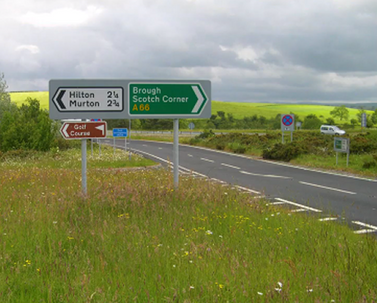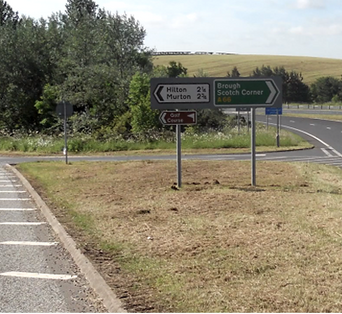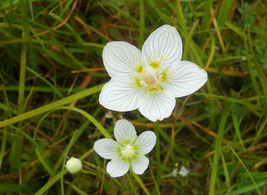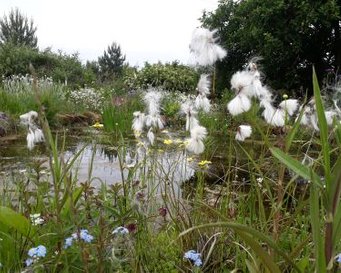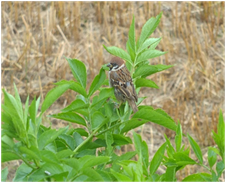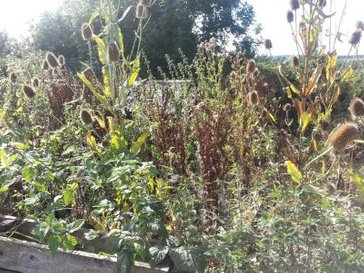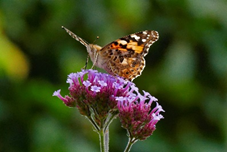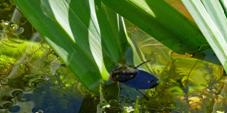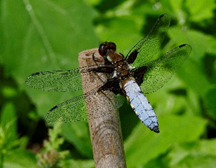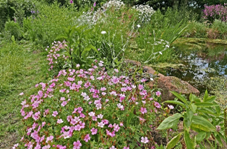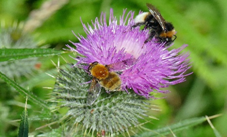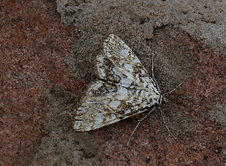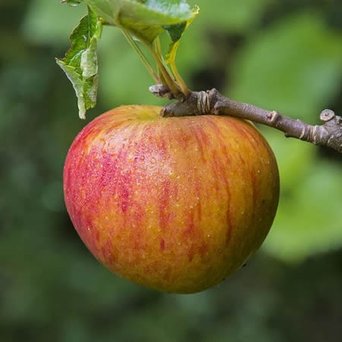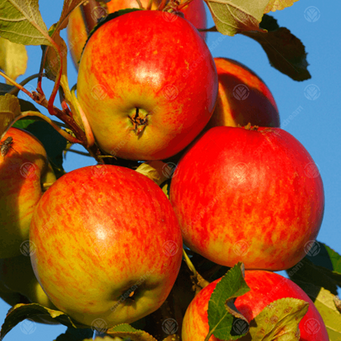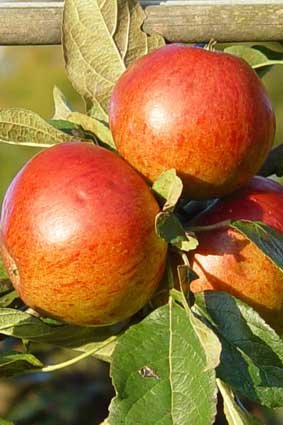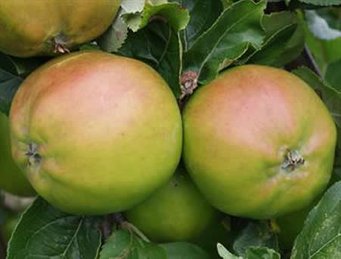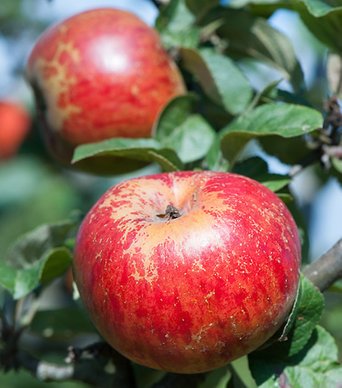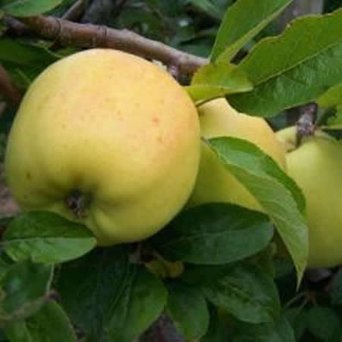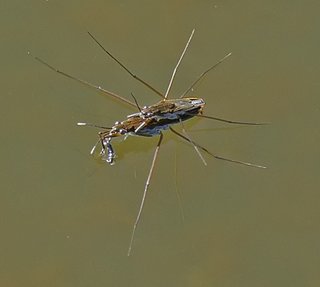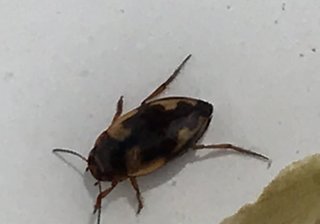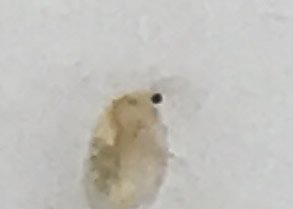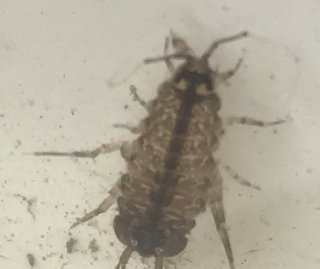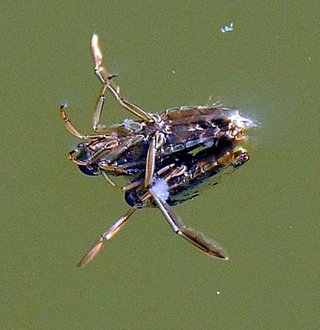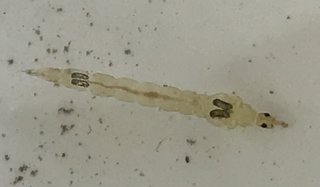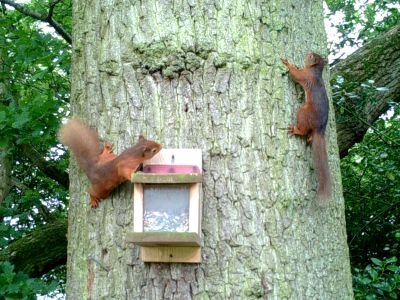The importance of roadside verges
Above, verge with abundant beautiful wild flowering plants, habitat and food for wildlife. Right, the same spot "tidied up".
far right, just two of the lovely plants cut down in their prime.
Those who are hell bent on eradicating "weeds" from our wild environment are causing damage not just to the native plants themselves but to the pyramid of biomass that they support. They provide wildlife corridors of cover for all species to hide from predators. They provide a place for insects, spiders, beetles and many other species to live, a "habitat". They are a food source for those that feed on plants. Those that feed on plants provide a food source for larger creatures, "consumers". The consumers get consumed in turn by the top predators. When the bottom level is "removed" all levels above suffer and numbers of mammals and birds fall through starvation.
When a roadside verge is mowed from the road to the hedgerow or wall everything is destroyed. There are tens of thousands of hectares of roadside verges in the UK. Just imagine how many species could live there if they were mot mowed back to a wall or hedgerow. If just one metre was mowed for motorists sightlines we would be in a far happier place than we are today.
You can read more by following this link:
41 percent of UK species have declined since 1970s. Author:Josh Davis First published 4 October 2019............... Source Natural History Museum (UK)
The loss of wildlife since the 1940s is even greater. KEG members are doing what we can to provide habitat, food, and cover for wildlife. What we do is small when compared with the massive damage that can be accomplished with machinery in very little time mowing verges.
We will continue, we won't give up. Small steps in one year can result in unexpected but delightful results. Using money raised via the Plant Auction and the KEG calendars a couple of years ago we bought bird and hedgehog friendly slug pellets. Metaldehyde ones kill slugs but they also kill hedgehogs and birds that eat the slugs. We said to anyone who would listen, "can we swap a full drum of these for any metaldehyde ones you have left"? Everyone asked agreed and swapped. This year we have seen evidence of far more hedgehogs than in previous years. People with trail cameras have reported seeing more too. This is anecdotal evidence, nothing has actually been measured but lots of people have commented.
It is worth noting that we only sell plants in the Plant Auction that produce pollen and or nectar. Many "garden centre" plants have been specially bred for their beauty. The growers are often interested in making money not in helping the environment. If we have an abundance of some plants we will give one away with the tomato plant that someone has just bid for. Last year we also bought boxes of wild flower seeds, packaged them into small envelopes and gave those away with bought plants. This distributes beneficial plants to people's gardens.
If you ask people to name a weed, many will say dandelion. In a research project carried out a few years ago at Leeds University, dandelion was found to be the single most important plant in the UK as a food source for pollinators. Ragwort, another "weed" came second. Some species of ragwort are very toxic to farm animals and horses so we understand why eradication from fields for grazing is vital but why not just leave them where this is not a problem.
Not everything is as it seems. Human decisions and behaviour result in many unintended or unforeseen consequences. It would seem that human consumption of wildlife in the far east is the cause of the current COVID19 pandemic (2020 -2021). Eating farmed food is infinitely safer and supporting British Farming by caring about animal welfare and minimising the number of miles food travels will help the environment enormously.
Howard Quinn
~~~~~~~~~~~~~~~~~~~~~~~~~~~~~~~~~~~~~~~~~~~~~~~~~~~~~~~
2020
January 2020
We have accepted the RHS invitation to participate in the Britain in Bloom competition this year. Due to COVID19 both CiB and BiB are postponed for a year
Well done everyone in the village who made an effort in 2019. BIB is by invitation only and you have to win your category competition before even being considered
Click here to see the Kirkoswald Cumbria in Bloom page for 2019 results. We did really well.
~~~~~~~~~~~~~~~~~~~~~~~~~~~~~~~~~~~~~~~~~~~~~~~~~~~~~~~
Millie Bank
As we did our first tasks we noticed the amazing flora on Millie Bank and began to take steps to preserve that. Then we installed an information board to help tell others of the beauty on their doorstep.
Millie Bank is a rare remaining example of traditional Eden Valley Pasture. Its steepness has made it impossible to 'improve' by ploughing and/or treating with artificial fertiliser, and, as a result, it has retained its wealth of flowering plants. By mid-Summer, the pasture was a colourful blaze of flowers.
The field had been grazed for many years by Shetland ponies and the occasional sheep. Grazing ceased altogether in 2012 after which there was a profusion of butterflies and wild flowers including some orchids. A survey identified well over 130 species of flowering plants, grasses. We worked on Millie Bank for several years eventually replacing the fencing so it could be grazed. Once the fencing was complete the land agent has let the land for sheep grazing. They have made a big difference to the coarser species. We were concerned that the previous tenant left too many sheep on for too long so sheep ate all of the flowers.
KEG has managed to reach an agreement with the owner’s Land Agent, and the intention is to graze it only during the Autumn and Winter in the future. Sheep were taken off at the start of 2019 because the field’s fencing was in a very poor state. This allowed Spring flora to appear for the first time in three years. Summer flora have also responded positively to the cessation of grazing with over 40 species of flowering plants noted on 23 06 19 (including carpets of bird’s-foot trefoil, betony, ragged robin, greater and lesser stitchwort), 14 different grasses (including hybrid fescue), and a range of rushes and sedges (including green-ribbed sedge). Unfortunately, the past few years of year-round grazing have allowed creeping thistle, nettle and docks to thrive, but a concerted effort is being made to remove/reduce them - in between fencing repairs!
In the 2019 Cumbria in Bloom Awards we were awarded 28 marks out of 30 for "Consideration of the Environment" in the General Judging, 28/30 for "Community Participation". our total score for 2019 was 96/100.
We won the National RHS award "Greening Grey Britain" Grow for people, Wildlife or Planet Award scoring 100%.
RHS "It's Your Neighbourhood Award "Millie Bank" 95/100 "Outstanding". This reflects recognition of our efforts over the past 9 years to conserve Millie Bank.
Sue Quinn October 2020
Work parties of socially distanced KEG members over both 2020 and 2021 have taken place on Millie Bank.
The aim was to remove "rank" species such as creeping thistle, common ragwort, and dock to reduce competition with the diverse range of species KEG members wish to encourage. Pulling thistles out is the best method of removing them but difficult on steeper slopes due to the danger of volunteers falling. Nettles provide habitat and food for insect larvae so are left in verges and shaded areas but controlled on open spaces. We use no pesticides or herbicides, just mechanical methods such as cutting and scything. Cutting pastures at the right time if they are not grazed encourages the desired species. Soil enrichment with fertilisers has to our knowledge never happened on Millie Bank and is one of the reasons that it is the way it is.
KEG members originally formed to help with the entry to the Cumbria in Bloom Competition, but have evolved into an environmental group.
Our first actions were to demolish a dangerous and unsightly ex teenage den in the woods.
We went on to formulate a plan to improve the path along the Raven Beck through Millie Bank and into Common Wood with the help of CCC highways team.
As mentioned elsewhere on this website many villagers refer to it as "the common". It is not Common land, it is owned and used to be let out for grazing to a villager who kept Shetland ponies. This kept its unusual status as "unimproved pasture". Before 1950 much land was like this and very rich in diverse plant species and the other living creatures the plants support.
Pesticides and fertilisers are not used on Millie Bank.
Howard Quinn
Millie bank plant species list 2021
~~~~~~~~~~~~~~~~~~~~~~~~~~~~~~~~~~~~~~~~~~~~~~~~~~~~~~~
Millie Bank Grazing updated 03/10/2021
Sheep have once again been placed on Millie Bank over winter. These Jacob lambs are bred locally, and their grazing habits are ideal to help preserve the wild flowers that grow on this steep bank.
Despite its local name of ‘The Common’, this field is private agricultural land and the public must keep to the footpath at the base of the field - no other public rights of way exists on this land. You are reminded that all dogs must be kept on a lead at all times through this area.
Pregnant ewes will be added on to the land later in the year and so all dog owners are asked to be extra vigilant in controlling their dogs.
Without regular controlled grazing nettles, thistles and briar etc. will take over, with over grazing the animals eat all the flower shoots.
Thank you for your co-operation,
Ruth Anderson MBE, Chairman,Kirkoswald Environmental Group.
Projects in 2019 and before
Who wrote each part of what follows will give you an idea of how many people are involved. There are many more participants who do not write. They are just as important, active supporters who give practical help to get things done.
Bee Corridor
Ethos
KEG members have developed a "bee corridor", with plants for pollinators at various spots in the village. Above and below the sports field, we have planted boxes outside unoccupied properties and developed the verge below the Bell Tower.
We do try to grow and sell plants to encourage pollinating insects, which are then spread around the area, and if there are too many we plant them in roadside verges or similar places. The plant boxes we maintain outside George House and Wordsley House are stocked with pollinator friendly plants. We aim to "Give Bees a Chance" to misquote John Lennon. There are lots of pollinators other than bees also supported by such planting. Many flowers for gardens have been developed for their scent and appearance. In the past plant breeders have not been concerned with providing pollen or nectar so nice looking plants are sold which do not benefit wildlife at all.
Howard Quinn
Planting at the top of the allotments
Many passers-by stop to look over the wall to admire the allotments and pass the time of day. This year Kirkoswald Environment Group decided to enhance the corner by the gate, to reflect what people cannot see at the far end of the allotment field. To this end, part of the bank was dug over and a variety of nectar-rich plants introduced, bringing more colour and diversity, and hoverflies, bees and butterflies for all to enjoy. Other parts of the hedgerow and bank have been left with long grasses, wild flowers and some nettles to provide suitable habitats for a range of species, for example for local barn owls to hunt and moth and butterfly caterpillars to feed.
Planting by the Wall
On the way into the village (near the garage) there is a narrow strip of verge which has been sprayed in recent years, resulting in an unattractive sight as people enter the village. During the Spring of 2018, a section of the verge was tidied up (removing docks and nettles, but leaving any wild flowers such as cow parsley and white dead-nettle), and some plants such as foxglove, celandine, shining cranesbill and red campion were planted. Unfortunately, the Great Drought of 2018 began not long after planting, and it is not practical to water the area, but it has some colour for the first time for a long time, as can be seen in the picture below. More verge has been worked on in subsequent years. Since Covid19 struck we have worked in same household pairs and more latterly socially distanced small groups.
Sue Quinn
Planting at the Sports Field
Kirkoswald benefits from a well used sports field. The school uses it regularly for a variety of sports activities and it is also home to Staffield Cricket Club and Kirkoswald football club. League matches for children and adults are regularly held there. The margins of the sports field are generally left to wildlife and host grasses and nettles mostly. It was agreed that the section nearest to the entrance gate would benefit from some attention, and on 1st May members of the Kirkoswald Environment Group arrived with strimmers, spades and forks to 'attack' it. Areas of the margin were cleared of grass and weed roots and clumps of mainly native perennials were planted along an area of approx 15 sq m, species were chosen which are attractive to pollinators. The area is directly before the further field margin which the environment group helped the school to clear last year. They now have raised beds there with attractive willow woven borders and herbs, flowers and vegetables planted. The school children can now walk past the newly planted field margin, which six weeks after planting is sporting flowering pelargoniums and other perennials just coming into bud.
Ruth Anderson MBE
~~~~~~~~~~~~~~~~~~~~~~~~~~~~~~~~~~~~~~~~~~~~~~~~~~~~~~~
Orchard and wildlife area
About five years ago we started to tackle the allotments at the bottom of the allotment fields that had fallen into wilderness. This formed an Allotment Orchard group which consists of allotment holders, several of whom are also Keg members. The orchard was developed first followed by the wildlife area and pond.
The allotments and Orchard / Wildlife area was awarded 100/100 "Outstanding". In 2018 and 2019. We won an National Royal Horticultural Society Award for it, "Outstanding".
Howard Quinn
Orchard area before redevelopment
Cottongrass at the Orchard pond
Orchard and wildlife area during redevelopment
Tree sparrow
Hemp agrimony
Butterflies at Millie Bank
Millie Bank has many nectar rich plants where butterflies can feed and larval food plants special to each species. On sunny spring days, Orange Tips and Green-Veined Whites patrol, and Peacocks, Commas and Small Tortoiseshells emerge from hibernation to bask in the warm sunshine. Second generations of the last three species, together with Red Admiral, may also be seen in late summer and autumn. In high summer Ringlet, Meadow Brown, Small Copper and Common Blue offer a colourful spectacle.
Clive Griffiths
~~~~~~~~~~~~~~~~~~~~~~~~~~~~~~~~~~~~~~~~~~~~~~~~~~~~~~~
The Allotments – Habitats and Wildlife
Gardens and Allotments have a vital role to play in mitigating the alarming decrease in Britain’s bio-diversity. Our allotment field in Kirkoswald reflects our desire to help protect and encourage wildlife. To this end we have protected and augmented existing features and practices, and developed new habitats to encourage a wider range of species to visit and colonise. Through profits from the village environmental group’s plant sale we have been able to offer allotment holders free wildlife-safe slug pellets and distribute packets of wildflower seeds. Of course various forms of wildlife have always utilised the hedgerows and banks with nesting Greenfinch, Goldfinch, Chaffinch, Blackbird and Song Thrush being long term residents. Likewise, Hedgehogs have regularly foraged for food, the latter species and Song Thrush being great eaters of garden pests. We hope that they will benefit from the safe slug pellets as unfortunately there have been poisoning incidents in the past.
Extra man-made artefacts have extended habitat provision. There is a log pile for wintering invertebrates, a hedgehog wintering “quarters” and nest boxes which are occupied by Tree Sparrows. The features of which we are most proud are the extensive “nectar banks” of suitable flower/wildflower species and our large pond. Both of these are located in our recently created Wild-life Garden. The two years of its existence has seen it develop to maturity and attract a range of species. Hemp Agrimony is a butterfly magnet in late summer, with one stand holding 17 butterflies of four species, on one memorable instance last August. The pond has attracted Dragonfly species like Southern Hawker to breed, together with three species of Damselfly, and the spectacular Broad bodied Chaser(f) to take up temporary residence. Great Diving Beetle (b), Common Newts, Frogs and Water Boatman arrived of their own accord, as did the Brown China Mark moth (g) which has an aquatic larva. Incidentally the Environment Group’s plant sales have also reflected the desire for more provision of nectar rich plants and a move away from the sterile “dabs of colour that have provided cold comfort for nectar seeking pollinators in the past. It is sad that garden centres and D.I.Y. garden departments continually shelve their responsibilities in this respect. As they do with a range of insecticides and herbicides which they push as being a necessary adjunct to gardening and horticulture. Our continuing aim at the allotments is to provide a legacy of enlightened good practice in terms of a balance of land use, which can be passed on to new younger allotment holders in future years.
Clive Griffiths
Great diving beetle
Broad bodied chaser dragonfly
Many species of bees and other pollinators are supported
Brown China moth
~~~~~~~~~~~~~~~~~~~~~~~~~~~~~~~~~~~~~~~~~~~~~~~~~~~~~~~
The Allotment Orchard
The orchard, started in 2014, was done in two phases by volunteers who transformed a neglected and overgrown site. The trees were donated, bought or grafted with the stipulation that the apple trees, which were to be the most numerous, should either be heritage varieties or those that would grow well in our challenging climate. This ended with a good eclectic mix.
We have three plums - Denniston’s Superb, Marjorie’s Seedling and Victoria (best dual purpose plum), Shropshire Damson (regarded as the best flavoured damson) and for pears we have Williams (probably the most grown pear in the world and Beth (small and well flavoured).
As for apples, which are the easiest to grow, we have Ribston Pippin (a parent of Cox’s Orange Pippin from Yorkshire), Red Falstaff (a comparatively new introduction), Sunset (the best variety to grow in Cumbria as a replacement for Cox), St Edmunds Pippin (regarded as the best russet), Spartan (well known popular variety), James Grieve (a reliable dual purpose Scottish Apple), and last but not least Chiver’s Delight (introduced in the 1920s, a Cambridgeshire apple that didn’t gain the popularity it deserved. This variety grows very well in the north of England, especially Cumbria, where the growing season is long, cool and moist which gives it a concentrated sweet/sharp flavour, which in my opinion is superior to Cox’s Orange Pippin, the aficionados benchmark for dessert apples. For culinary apples we grow four heritage varieties, the ubiquitous Bramley’s Seedling (from the early 1800s that gave rise to the only culinary variety that most people now know, and the parent of millions of grafted trees, that has recently come to the end of its illustrious life). Queen (a large apple raised in 1858), Keswick Codlin (very early, small, with good acid flavour) and Golden Noble (first mentioned 1769, Pontefract, Yorkshire. This variety was the favourite bar none of the Victorians, valued for its superb fruity, sharp flavour, that needs to be balanced with just a small amount of sugar - far less than Bramley’s - perfect for those wanting to cut down on sugar, and with the added bonus of not going brown when peeled and sliced. A good case for keeping heritage apples alive).
We have secured a rare dessert apple named May Queen and are doing our part to save this variety from going extinct and are trialing some new varieties that we have bred ourselves crossing two varieties of culinary apples.
Dave Fernie
St Edmund's pippin
Spartan
James Grieve
Chiver's delight
Ribston pippin
Red Falstaff
Sunset
Keswick Codlin
May Queen
Golden noble
~~~~~~~~~~~~~~~~~~~~~~~~~~~~~~~~~~~~~~~~~~~~~~~~~~~~~~~
03/02/2017
Litter picks
A litter pick was carried out by KEG members, members of the public and children from K'o School in the morning. An analysis of categories of litter were carried out by a group of children in the afternoon.
You can reach your own conclusions about who may be dropping what on village approaches. There was almost no litter in K'o itself. Click a litter image to enlarge
KEG volunteer litter pickers
Storm Desmond resulted in KEG members and other volunteers picking litter to fill 100 blue bags and winning an RHS Cumbria in Bloom Special award for flood recovery activity.
In Autumn 2017 a group of 7 picked litter from the higher reaches of the Parish round Renwick.
A litter pick was carried out by KEG members on March 18th 2018 on approach roads to K'o. 16 Eden bin bags of litter were collected. Sadly the very next day litter began to appear again.
Seen on a very littered road in Scotland: an illuminated sign which says "Litter picking risks the lives of road workers". Food for thought, litter droppers!
I hope that rather than being an excuse for not cleaning the mess up that the message was "take your litter home" - litter picking poses a serious risk to people who do clean it up. In 2018 a KEG group did a pick covering the village and all of the bottom half of the Parish. People went out at different times and deposited the bags at Langdon House for the collection arranged with EDC. There are now quite a few people who pick regularly. This year we were joined by the Girl Guides who were allocated a safer area to pick and found a few bags worth.
We will pick around Renwick again in the Autumn.
Sue Quinn
~~~~~~~~~~~~~~~~~~~~~~~~~~~~~~~~~~~~~~~~~~~~~~~~~~~~~~~
Bird Life along the Raven Beck
Dipper and Grey Wagtail frequent Raven Beck, with Buzzards over the nearby plantations. In spring, Common Wood echoes to the songs of Nuthatch and Tree-creeper and to the drumming of Greater-Spotted Woodpecker. Later, summer migrants, such as Willow Warbler and Blackcap, add their distinctive voices. In autumn groups of Siskin and Redpoll feed in the upper canopy, and, in winter, foraging parties of Long-Tailed Tits roam the woodland. Adjacent to Common Wood is a mature conifer plantation home to Goldcrest, Jay and Red Squirrel.
Common Wood
Common Wood is naturally regenerated mixed woodland with a rich flora. In early spring, Wood Anemones and Bluebells carpet the ground, with Marsh Marigolds and Golden Saxifrage on wetter flushes. Later these flowers are replaced by huge swathes of Wild Garlic, and Dog’s Mercury which thrive in the deeper shade. Summer sees Herb Robert, Wood Cranes-bill and Woundworts flourishing in the sun dappled areas.
Clive Griffiths
~~~~~~~~~~~~~~~~~~~~~~~~~~~~~~~~~~~~~~~~~~~~~~~~~~~~~~~
18/02/2017
Bark and Bud Walk
Several Keg Members enjoyed a walk and talk about identifying tree buds and bark. Many people can identify trees quite well when they are in leaf. Nigel and Lois made it seem simple identifying trees from looking at their unopened buds and their bark. Now we just have to try and remember it all.
~~~~~~~~~~~~~~~~~~~~~~~~~~~~~~~~~~~~~~~~~~~~~~~~~~~~~~~
K'o Calendars for 2023
Kirkoswald Environmental Group Calendar Competition
We will run the calendar photo competition this summer and produce a 2023 Kirkoswald Civil Parish Calendar. We will return to the original format where we ask people to choose up to three of their favourite images of places in the Parish. We do not normally choose images with people on them.
Please print these and write on the back the following information:
Your full name
Contact telephone number
E-mail address
The month that the photo was taken
Brief description of what is shown in the image/where the image was taken.
You can put two images on an A4 page to save money of printing. Please put the printouts into an envelope with your name on it. There will be a box for entries in the Community Shop and for outside of opening hours you can place them in the remote post box or through the door at Langdon House.
Liz Cave will be collating and organizing judging. We will pick one portrait format image for the front cover; this can be of any month. We will pick 12 landscape format images, one appropriate for each month of the year. Any photos taken over the past 18 months are acceptable. Photos must be of a large enough pixel size for print quality. A minimum of 2480x1748 is recommended, larger files are fine 4 by 3 format is best. The deadline is Saturday 06/08/2022. Howard will be in contact with people who have bought calendars in the past by e-mail, preordering really helps us decide how many to print. They make great presents. Proceeds will be spent on environmental projects within the Parish.
Howard Quinn
~~~~~~~~~~~~~~~~~~~~~~~~~~~~~~~~~~~~~~~~~~~~~~~~~~~~~~~
Pond dipping
Allotment pond
April 2017 update. whilst some allotmenteers were digging out undesirable plants from the orchard and wildlife area others were pond dipping to monitor species that have colonised the pond. Many thanks to Martin and Lois for identification and photos.
When pond dipping, biologists use a white enammeled steel dish. They collect some pond water and observe that. Then a fine mesh net is used to collect species and tip them into the water. The white background makes the creatures collected easy to observe. Once recorded everything is returned to the pond. Aren't phone cameras great for recording species! 45 years ago we had to record by drawing.
Species books are still a useful aid here but internet connected phones would be too.
Howard April 2017
Pond scater with prey item
Water beetle
Daphnia
Water louse
Water boatmen male and female mating
Phantom midge larva
~~~~~~~~~~~~~~~~~~~~~~~~~~~~~~~~~~~~~~~~~~~~~~~~~~~~~~~
20/04/2017
Bird box building
A number of KEG members got together at Nick and Ruth's and built a 13 bird boxes with holes or slots of different sizes and heights from the floor. This is to attract and suit different bird species. Most will be sited at members houses or the pond orchard to provide nesting spaces. A few will be on sale at the Plant Auction in June
One of the joys of gardening is the way that it brings you closer to nature. Whether it’s a robin helping himself to grubs from freshly-dug soil, or a songbird providing music whilst we work, birds are an important part of the garden landscape. And while we may curse the pigeons who take our brassicas, most gardeners want to encourage birds in our gardens, particularly when we read of the decline in the populations of some of our native species. Indeed, the RHS lists blue tits as one of the control methods recommended for pests such as the codling moth. So, how do encourage them?
About once a year members of our environment group get together to make bird boxes. To simplify this, one of us will purchase the timber( which is not tantalised ) and cut out the pieces. Members of the group then fasten them together, with varying degrees of success. The finished articles are either auctioned off at our annual plant sale, or put up around the village. Some are now down by our wildlife pond on the allotment field, whilst others are in Common Wood, or in peoples gardens around the village. Over the last six years we must have spread over a hundred bird boxes around our village.
To encourage a variety of birds we make boxes with a range of hole sizes, from 25mm for tits to 45mm for starlings. Other species, such as robins, wrens, and spotted flycatchers prefer an open-fronted box, so we also make these. One year we concentrated on boxes for swifts, which have to be sited high on a building with an open approach, and these seem to be working - the skies over KO are currently full of these noisy visitors, and this morning we found an egg shell on the ground beneath an occupied box, so something seems to have worked. Our other swift box has been commandeered by starlings, who have bred successfully (and noisily, by our bedroom window!) for the last two years, even though we have told them that they are in the wrong kind of box.
We have also made bat boxes, and this year are planning to build homes for hedgehogs.
The scheme is still in its’ infancy, but we can already say that we haven’t seen any ‘old’ style slug pellets on our allotment field this year, and that other gardeners around the village have also traded in the nasty sort for the new alternative. Gardeners aren’t bad people, so once they see that the ‘new’ type work, we hope that they will stick to them. We have already handed in a boxful of metaldehyde - containing pellets to the County Council for disposal. We will obviously continue to monitor the situation, with periodic reminders, and a continuation of the amnesty scheme. It’s got to be worth a try.
Nick Anderson Aril 2017
~~~~~~~~~~~~~~~~~~~~~~~~~~~~~~~~~~~~~~~~~~~~~~~~~~~~~~~
The Plant Auction
Most gardeners swap plants with one another, and we all moan about the robbers who run garden centres, so six years ago we decided to try to hold an auction of peoples spare produce. Most of us produce too many seedlings ‘just in case’, and these often go to waste, so we encourage people to donate these, and any spare plants that they might have, and we auction them off to raise money for environmental projects within the parish.
It began small, but has steadily grown over the years, and is now a firm fixture in the villages diary, usually being held at the beginning of June. Sometimes things don’t go quite as we would wish - two years ago we were inundated with tomato seedlings, so that we were giving them away, so of course last year we had almost none. We do try to grow and sell plants to encourage pollinating insects, which are then spread around the area, and if there are too many we plant them in roadside verges or similar places. We also have some generous supporters - one local lad last year made us two lovely sandstone planting troughs, and this year we were given a Cercis siliquastrum, the Judas tree, which got the customers bidding. We also sell bird boxes, jars of home-made jam, and almost anything else that we can.
One of our local pubs Kindly gives us space to hold the auction, (and then sells a lot of drink to the customers, which encourages them to make generous bids.) The amount that we make varies, between about £250 and £500, all of which goes to support the work of our Environmental Group. Everyone has a good afternoon, and we all go home with a variety of new plants.
Nick Anderson June 2019
Due to COVID19 no plant auction was possible in 2010 or 2021. We hope to have one again in 2022
Howard Quinn October 2021
~~~~~~~~~~~~~~~~~~~~~~~~~~~~~~~~~~~~~~~~~~~~~~~~~~~~~~~
Woodland Management
The landowner of Common Wood was concerned about the number of non native trees in the wood. Through the winter members of KEG felled sycamores and removed some of the wood, leaving some to enhance habitat. This year we repaired part of the path through Common Wood ourselves. The path had been eroded by another minor flood. It is in an area where the floods of 2012 left a huge bank of stone leaving the path at some points lower than the beck so liable to flooding. We repaired the path using some of the larger stones thrown up and some of the sycamore to weave an edge.
Nick and Ruth Anderson
~~~~~~~~~~~~~~~~~~~~~~~~~~~~~~~~~~~~~~~~~~~~~~~~~~~~~~~
24/01/2017
Red Squirrel News
Squirrel feeder installation
Our local Squirrel warden, John Lisle, accompanied KEG members on a walk along Millie Bank, Common Wood and Black Plains to see what natural red squirrel food and habitat was present and to look for evidence of reds themselves. John sited two feeders which Martin will keep topped up and monitor.
We are now members of Penrith & District Red Squirrel Group and are cooperating with their Squirrel Ranger, John Lisle. Martin Thomas is the KEG member coordinating information. If you see any red or grey squirrels please either phone Martin on 07765 888987 or John on 07841 449648 or e-mail redquirrels@kirkoswald.org with the date, time and location of the sighting. This is especially urgent with greys as they need to be controlled as most carry squirrel pox which they are immune to but it almost always kills red squirrels in a very painful manner.
More at http://www.penrithredsquirrels.org.uk
Red squirrel monitoring using automated trail cameras. This is done in conjunction with the Red Squirrel Warden
These red squirrel were seen on one of the two feeders we installed in Common Wood.
We are using a squirrel mix which contains maize. None has been taken so far. Grey squirrels eat maize, reds do not. Disappearance of maize indicates that grey squirrels are present. Reds are taking the contents that they do like. The feeders don't just help the reds, they allow us to detect greys.
Red Squirrel project
In 2018 the main project for KEG was to help support and maintain our population of red squirrels. Martin Thomas, a KEG member has done a lot of work with small mammals. We worked with Penrith and District Red Squirrel Group and their warden, John Lisle. John came and assessed the area placing 2 and then a 3rd feeder along the Raven beck. We have a supply of food, from the Bird’s Bistro, at a discount and the feeders are topped up by members who walk up the beck regularly. We have purchased some trail cameras to monitor activity. These enabled Martin to spot the grey squirrels. Traps were set which have to be checked twice a day by law. One trap contained a hedgehog who was released after a struggle, with no harm to the hog but leaving a prickled Martin. We now have several volunteers who help monitoring. Some of the pictures are wonderful to see.
Martin gave a talk in the Church Institute which was attended by nearly 40 people including children with parents. To advertise the event we did a display in the shop window. This was greatly enhanced by some work from the school. Some pupils had done a lot of research into red squirrels and recorded their findings for us. There is a growing email list of people who receive regular updates and photos about the red squirrel population.
Awareness of the dangers greys can pose has been raised and people are regularly reporting sightings. Unfortunately we saw some evidence of squirrel pox and then fewer and fewer sightings of reds. We continue to monitor and hope.
Martin Thomas
~~~~~~~~~~~~~~~~~~~~~~~~~~~~~~~~~~~~~~~~~~~~~~~~~~~~~~~





















